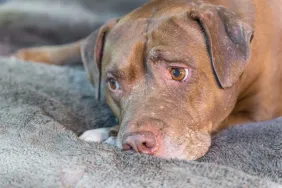Think of all the things your dog digs in, runs through, pounces on, rubs against, and rolls in. Many of them contain things that your dog’s immune system must combat to keep him healthy. But dogs will be dogs, and you can’t stop them from coming into contact with muck and other nasty things.
So it’s up to you to help keep his first line of defense—his skin and coat—as healthy as possible. But how? Let’s start by taking a look at how your dog’s skin works.
The skinny on skin
You may not think of your dog’s skin as an organ, but it is. In fact, it’s his largest organ. A dog’s skin—working in conjunction with his coat—serves several vital functions, including:
• Protection against the outside world
• Moisture retention
• Temperature regulation
You may be surprised to learn that your dog’s skin is actually thinner than yours. However, even though it seems like a thin (but supple) armor of protection against the outside world, your dog’s skin has three different layers:
• Epidermis. This is the outer layer, the one that bears the brunt of your dog’s wanderings in—and contact with—the world around him. The cells in the epidermis are replaced frequently when older cells become damaged.
• Dermis. This incredibly tough layer is mostly made of collagen, a very strong and fibrous protein. The dermis is the layer where blood vessels deliver nutrients and oxygen to the skin. The dermis also acts as your dog’s “thermostat” by allowing his body to release or keep in heat, depending on the outside temperature and your dog’s activity level.
• Subcutis. This is a dense layer of fatty tissue that lets your dog’s skin move independently from the muscle layers below it, and provides insulation and support for the skin.
Basics of keeping your dog’s skin & coat looking great
A visibly healthy skin and coat is considered to be a cue to the overall health of a dog. If a dog is unhealthy or is suffering from a diet that is low in essential nutrients, it will be reflected in the health of his skin and coat—and even the best professional groomer won’t be able to make his coat shine.
Here are some basic steps you can take to help maintain the health of your dog’s skin and coat:
Keep baths to a minimum. Bathing removes natural oils from the skin and can increase the chance of developing dry, flaky skin. Consult with your vet about the recommended number of baths per month for your dog.
When you bathe your dog:
• Use warm water in a warm room. Cold temperatures will dry out your dog’s skin and might give him a chill.
• Use mild shampoo that is specially formulated for dogs. Human soaps and shampoos are formulated for human skin pH and may cause dry, irritated, itchy skin.
• Use thick, absorbent towels instead of a blow dryer. If you must use a blow dryer, put it on the lowest setting and be aware of how hot your dog is getting.
Brush your dog regularly. Brushing improves circulation, and clean, unmatted fur lofts and holds warmth in. Brushing also helps distribute the skin’s oils around your dog’s coat. These oils provide his coat’s shine and help repel water when it’s rainy outside. This also helps to keep your dog’s skin warm and dry. Unbrushed, matted fur not only makes your dog uncomfortable, but can also be unhealthy.
Never shave your dog down to the skin. It’s fine to give your dog a trim, as needed, in summer—but for added warmth and protection, be sure to leave his coat a little longer in the winter. Consult with your vet or a professional groomer before trimming your dog’s coat.
The role of nutrition in skin & coat health
Nutritional deficiencies or a poor-quality diet can negatively impact the health of a dog’s skin and coat. The researchers at WALTHAM, THE WORLD’S LEADING AUTHORITY ON PET CARE AND NUTRITION®, have identified linoleic acid and zinc as two of the most important nutrients dogs need for healthy skin and coat.
Their research also indicates that for those essential nutrients to be most effective in increasing skin hydration and coat shine and softness, they should be delivered together and at levels above minimum requirements.
Based on the WALTHAM® research, the PEDIGREE® Brand has reformulated all its dry foods to contain zinc and leading levels of linoleic acid.









